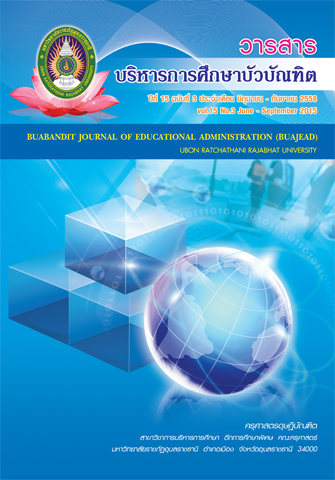รูปแบบการบูรณาการระบบการประกันคุณภาพภายในกับการบริหารสถานศึกษา สำหรับสถานศึกษาขั้นพื้นฐานขนาดกลาง
Main Article Content
บทคัดย่อ
การวิจัยนี้มีวัตถุประสงค์หลักคือเพื่อพัฒนารูปแบบการบรูณาการระบบประกันคุณภาพภายในกับ การบริหารสถานศึกษา สำหรับสถานศึกษาขั้นพื้นฐานขนาดกลาง สังกัดสำนักงานคณะกรรมการการศึกษาขั้น พื้นฐาน โดยการดำเนินการเป็น 3 ขั้นตอนคือ (1) การศึกษาข้อมูลพื้นฐานในการพัฒนารูปแบบ (2) พัฒนา รูปแบบโดยการร่างรูปแบบจากข้อมูลที่ศึกษาในขั้นตอนที่หนึ่ง และปรับปรุงรูปแบบโดยการสนทนากลุ่ม และ (3) ประเมินรูปแบบโดยการนำรูปแบบไปทดลองใช้ในสภาพจริง และการประชุมอิงผู้ทรงคุณวุฒิ เครื่องมือที่ใช้ ในการวิจัยประกอบด้วยแบบบันทึกการศึกษาเอกสาร แบบบันทึกข้อมูลสนทนากลุ่ม คู่มือการนำรูปแบบไปใช้ แบบประเมินสภาพการดำเนินงานตามรูปแบบ แบบประเมินความพึงพอใจของบุคลากร แบบบันทึกผลการประเมิน คุณภาพภายนอก และแบบประเมินรูปแบบ กลุ่มเป้าหมายและผู้ให้ข้อมูลสำคัญประกอบด้วยผู้บริหาร ครู ผู้รับผิดชอบงานประกันคุณภาพภายใน และผู้แทนครู จำนวน 21 คน บุคลากรของสถานศึกษาที่ทดลองใช้ รูปแบบ 45 คน จาก 3 โรงเรียน และผู้ทรงคุณวุฒิและผู้แทนสถานศึกษาที่ทดลองใช้รูปแบบ จำนวน 15 คน วิเคราะห์ข้อมูลโดยใช้ค่าความถี่ ฐานนิยม ค่าเฉลี่ย ส่วนเบี่ยงเบนมาตรฐาน และวิเคราะห์เชิงเนื้อหา
ผลการวิจัยพบว่าองค์ประกอบหลักของรูปแบบมีสามองค์ประกอบ คือ (1) ความรู้พื้นฐานของบุคลากร ในการดำเนินงานตามรูปแบบประกอบด้วยทฤษฎีพื้นฐานในการบูรณาการ มาตรฐานและตัวบ่งชี้คุณภาพการศึกษา และสภาพปัญหาและความต้องการของสถานศึกษา (2) ขั้นตอนการดำเนินงานตามรูปแบบนั้นประกอบด้วย การวางแผน ซึ่งมีการจัดระบบการบริหารและและระบบสาระสนเทศ การกำหนดมาตรฐานการศึกษาของสถานศึกษา และการจัดทำแผนพัฒนาการจัดการศึกษา ส่วนการดำเนินงานตามแผนนั้นเป็นขั้นตอนการนำแผนไปสู่การปฏิบัติ สำหรับการตรวจสอบผล ประกอบด้วย การติดตาม ตรวจสอบคุณภาพ การประเมินคุณภาพภายใน และการจัดทำ รายงานประจำปี และการดำเนินการต่อเนื่องเป็นพัฒนางานต่อเนื่องและเริ่มวงจรการบริหารรอบต่อไป (3) ผล การดำเนินงานตามรูปแบบนั้นมี 3 ส่วน คือ สภาพการดำเนินงานรูปแบบความพึงพอใจของบุคลากรต่อรูปแบบ และผลการประเมินคุณภาพการศึกษาภายนอก และเมื่อนำรูปแบบไปทดลองใช้พบว่าสถานศึกษาที่เข้าร่วม โครงการปฏิบัติงานตามรูปแบบอยู่ในระดับมาก บุคลากรมีความพึงพอใจอยู่ในระดับมาก และผ่านการประเมิน รอบสามทั้ง 3 โรงเรียน และประชุมอิงผู้ทรงคุณวุฒิพบว่า ผู้ทรงคุณวุฒิส่วนใหญ่เห็นด้วยกับรูปแบบอยู่ใน ระดับมากที่สุด ยกเว้นด้านการประเมินผลรูปแบบซึ่งเห็นด้วยอยู่ในระดับมาก
A Model of Integrating internal Quality Assurance System and School Administration for Middle-Sized Basic Education Schools
The main objective of this research aimed to develop a model of integrating internal quality assurance system and school administration for middle-sized basic education schools under the jurisdiction of the Office of Basic Education. The research was carried out in three steps: (1) investigating basic information for a model development; (2) developing the model; and (3) evaluating the model through actual situation implementation and verified by connoisseurship. Tools used in this research consisted of a data sheet template for document research, a focus group note-taking forms, a model implementation handbook, a survey questionnaire on the model implementation, a satisfaction evaluating questionnaire, and a model evaluation questionnaire. The target groups and key informants used in this researched included 21 focus group participants, 45 teachers and administrators from schools where the model was implemented, and 15 connoisseurs. The data were analyzed by means of frequency, percentage, median, means, standard deviation, and contented analysis.
The findings revealed that the three main components of the model were (1) the personnel’s basic knowledge to operate the model which included basic theories of integrating the model, educational standards and indicators, and the school’s states, problems, and needs. (2) The operating process of the model included (1) Planning, consisting of developing an administration system and management information system, setting schools’ educational standards, and planning educational development plans; (2) Doing, which was the step of implementing the plans; (3) Checking, which included monitoring and quality auditing, evaluating internal quality, and writing an annual report; and (4) Acting, which was a continuous quality improving step. (3) The model output, which included the states of carrying out the model, personnel’s satisfaction towards the model, and external education evaluation. The evaluation of the model by implementing the model revealed that schools’ performance was perceived as higher level, the school personnel were satisfied with the model at the higher level as well, and all three schools implementing the model passed the external evaluation. The model’s evaluation by experts showed that the experts rated the model at the highest level in most aspects except for the model evaluation which was rated as higher level.

